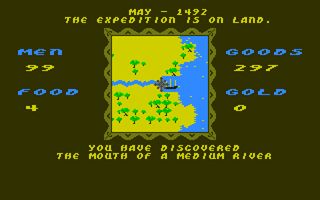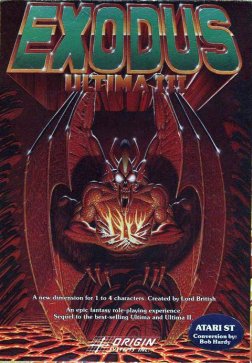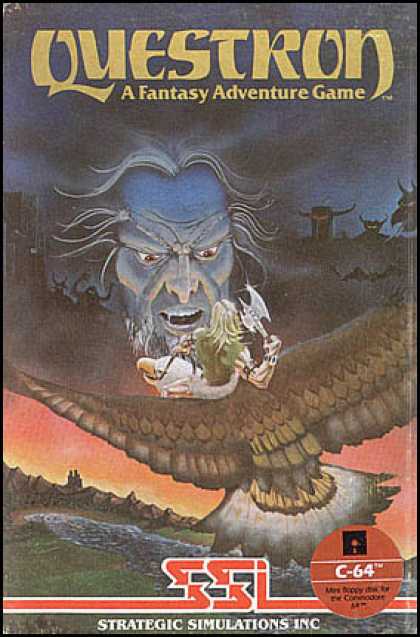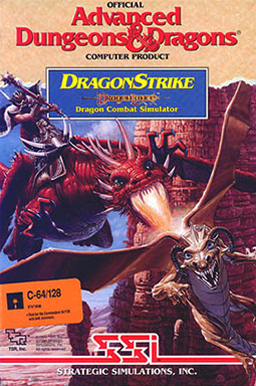In the final chapter of the "Games People Play" trilogy, I'll be discussing some of the video games I used to play as an impressionable youth.
It was the hip system at the time and cartridges flew off the shelves like shotguns in a zombie apocalypse. The graphics were weak and the sound was pretty horrendous compared to what was offered at the local Golfland or Timezone arcade, but it had the added convenience of being able to play at home. So you know, it had that going for it. I distinctly remember several decent games (and I say decent as it relates to the Atari only), like Adventure (the first game with an easter egg), Haunted House, Combat, Yars Revenge and Dragonfire. While these weren't exactly state of the arts games, they were entertaining to 9 year old.
Not long after my parents bought my brother and I the Atari, a friend of mine got the Intellevision, and the first game he got was Advanced Dungeons and Dragons. I was amazed at it. My Atari 2600 immediately began it's career as home for wayward dust bunnies. I couldn't even imagine that a computer character could look like anything other than a blue square, but here was one that actually had arms and legs and RAN! I spend many days and nights at his house that summer playing on his game system.
A year or two later, personal computers started to appear on my radar.

into his cassette drive and we would begin the 15 minute loading process so that we could play. Most times we would start loading the game and then walk over to the liquor store to buy candy and sodas. A couple of times he put the wrong cassette in (they were just blank white cassettes) and we would have to start the loading process all over again.
It didn't take too long before the 8" floppy disk was invented and quickly followed by the 5 1/4" floppy that was the standard for quite some time. That's about the time that I made my way down to Toys r' Us (yes, I said Toys r' Us) with my parents where they bought me my very own Commodore 64 and 5 1/4" floppy drive. Luckily we had an old black and white TV that I could hook it up to, so that saved them quite a bit of money. They also got me a couple of games for it, which were a lot of fun:
Choplifter

 From there, it was on me to save my allowance and buy my own games. This was a great time for computer gaming. None of the games had great graphics like they do today, in fact, most times the artists drawing on the cover was usually 1000x better and looked nothing like the game itself, so they designers had to create what they used to call a "story" to entertain people. I know what you're thinking "But 'stories' are just a myth right?" I beg to differ, story lines were real, but global warming and graphics cards have made them almost extinct. But if you know where to look, and if you're really quite, you might still be able to find them.
From there, it was on me to save my allowance and buy my own games. This was a great time for computer gaming. None of the games had great graphics like they do today, in fact, most times the artists drawing on the cover was usually 1000x better and looked nothing like the game itself, so they designers had to create what they used to call a "story" to entertain people. I know what you're thinking "But 'stories' are just a myth right?" I beg to differ, story lines were real, but global warming and graphics cards have made them almost extinct. But if you know where to look, and if you're really quite, you might still be able to find them.My friends and I started collecting games anyway we could. We would trade copies through other friends at school, buy them with our allowance, send away for them and even buy magazines with the code printed in the center that you could type in yourself. We played everything we could get our hands on, and there were some really fantastic games.
These were just a couple of the outstanding games that were offered back in the 80's. And in some ways, they are better than some of the crap that is churned today. Sure they didn't look that great, but the story would drawn you in and your imagination would take over.
Take Wasteland for example. The instruction booklet basically tells you that there was a nuclear war. You were a guard at a prison in the desert south east of Las Vegas and you forced the prisoners out and ushered survivors in. There has been some strange activity in the desert recently, go check it out. Period. That's it. From there, it leads you on a whirlwind adventure to an epic finally against enemies you would never expect. And all this from simple, non-animated graphics and a book of paragraphs that you need to read when it tells you to so it can explain what you see.
These games were the natural progression from table top gaming. It's almost like having a single player D&D game complete with maps drawn for you and miniatures. Nowadays, imagination is a dying art. Everything is spoon fed to you and if it's not, its considered a bust in the game world, or at best a "cult classic".
For more proof of the dying art of imagination in gaming, look at computer game manuals. Back in the days of Ultima you got a manual, a spellbook, a cloth map of the continent and outstanding artwork within. The artwork really helped transport you to the world even before you start the game up. I would read the books in the car on the ride home from the game store and get excited even before I could play. This is something that D&D and Gamma World and all of the other early-80's RPG would contain. This would help spark your mind and get your pulse racing. If you were taking a trip to another world, the artwork was driving the bus! Now, it's bare bones, bare necessities in the manual. Only what you need to play, nothing to get you motivated.
After all these years of gaming, I still have the manuals and spell books to all of my Ultima games. The cloth maps are framed and ready to hang on my office walls (as soon as I get motivated to hang them).
The only recent games that I can say really came close to this is Fallout 1 and Fallout 2. They really spent time on the manuals to give you the feel of the game world. They even came up with a character that is sort of their brand mark.
That character is almost iconic in the game world now. They just don't make 'em the way they used to.
The Ultima series, was a special collection of games written by Richard Garriott in the very early 80's all the way into the 90's. They started off simply enough as D&D-type computer games, but even early on they were just a little bit different. In Ultima II you could actually find a spaceship and, if you had the coordinates, fly to other planets. This was on top of the time-spanning adventure through the history of the continent.
 Ultima III was one of, if not the first game to allow you to play multiple characters in a party and create each one separately. Ultima IV introduced a moral compass to the adventure. You had to, as the avatar of good, follow certain principals in order to attain the highest level of "goodness". You could increase honor by not killing enemies that were fleeing the battlefield, compassion by giving to those in need, valor by not fleeing from your enemies etc. Where else can you get that element in a video game? Even today the concept is rare at best. Ultima VI had elements of racism and tolerance where in you begin the game with the impression that Gargoyles are evil creatures, but you come to learn that they are just trying to live their lives like anyone else.
Ultima III was one of, if not the first game to allow you to play multiple characters in a party and create each one separately. Ultima IV introduced a moral compass to the adventure. You had to, as the avatar of good, follow certain principals in order to attain the highest level of "goodness". You could increase honor by not killing enemies that were fleeing the battlefield, compassion by giving to those in need, valor by not fleeing from your enemies etc. Where else can you get that element in a video game? Even today the concept is rare at best. Ultima VI had elements of racism and tolerance where in you begin the game with the impression that Gargoyles are evil creatures, but you come to learn that they are just trying to live their lives like anyone else.
Not a very well known game as I recall, but I remember staying up till 2 or 3 in the morning playing this one. I found it on a game rack in the back of Montgomery Wards one Saturday, and I had $29.99 just burning a hole in my pocket so I bought it and immediately dove into the manual just as soon as we got to the car. It was your typical fantasy/ adventure game. Another D&D based game, but it had a lot of fun elements to it. The overland adventure was top down view, but inside dungeons was 3D. Nothing new at the time, but a nice touch just the same. Early in the game you had to contend with certain monsters being resistant to most weapons, so you had to do a little research to find their vulnerability. Inside towns was entertaining because in most you could do some gambling. There were several mini-games that you could play to increase your wealth. But be careful, break the bank and the guards would be looking to break you! Like I said, nothing ground breaking but fun none the less.
And then came the revelation in Dungeons & Dragons computer gaming.
The Dungeons & Dragons gold box series.
This jumped off with Pool of Radiance and was a phenomena among D&D computer geeks (which I happened to be). This had it all, level advancement, D&D rule system, magic items, non-linear quest line and customizable outfits for your characters (ok, just different colors really but you got to pick them yourself!).
I remember spending hours with a pad a graph paper and pencil by my side mapping this game so I would know where I was and where I had been. It was really a good start to the series. The follow up games: Curse of the Azure Bonds, Secret of the Silver Blades and Pools of Darkness, all allowed you to carry your character's over to the next game so you could keep advancing them just like in D&D. This was certainly a new concept in computer gaming and really gave you a sense of attachment to your character and a sense of accomplishment when you defeated the series.
More and more games come out in the D&D line but most were very similar to the original in terms of game play so they began to feel stale and rehashed. There was one notable exception however, Dragonstrike took a completely different direction on the franchise name.
Dragonstrike was based on the popular Dragonlance series of books and modules (more on that debacle another time) and was the first and possibly only dragon flight simulator. You played a young knight in the war of the lance and you were responsible for going head to head against the dragon riders of the enemy. You would pilot your dragon and attempt to defeat your rivals with a lance and with breath weapons. As you progressed through the game you would get more and more powerful dragons to ride.
This was a very fun and very difficult game to play, but you couldn't help but keep playing it once you started. I can't recall any other game out there quite like it even to this day.
There were numerous other games that I've played over the year. Far too many for me to go over or review here, but maybe I'll take one once in a while and do just that. These are just a cross section of what I was playing back in the early days of my gaming career. I hope some other people have had the pleasure of trying some of these games and enjoyed them nearly as much as I have.
The Ultima series, was a special collection of games written by Richard Garriott in the very early 80's all the way into the 90's. They started off simply enough as D&D-type computer games, but even early on they were just a little bit different. In Ultima II you could actually find a spaceship and, if you had the coordinates, fly to other planets. This was on top of the time-spanning adventure through the history of the continent.
 Ultima III was one of, if not the first game to allow you to play multiple characters in a party and create each one separately. Ultima IV introduced a moral compass to the adventure. You had to, as the avatar of good, follow certain principals in order to attain the highest level of "goodness". You could increase honor by not killing enemies that were fleeing the battlefield, compassion by giving to those in need, valor by not fleeing from your enemies etc. Where else can you get that element in a video game? Even today the concept is rare at best. Ultima VI had elements of racism and tolerance where in you begin the game with the impression that Gargoyles are evil creatures, but you come to learn that they are just trying to live their lives like anyone else.
Ultima III was one of, if not the first game to allow you to play multiple characters in a party and create each one separately. Ultima IV introduced a moral compass to the adventure. You had to, as the avatar of good, follow certain principals in order to attain the highest level of "goodness". You could increase honor by not killing enemies that were fleeing the battlefield, compassion by giving to those in need, valor by not fleeing from your enemies etc. Where else can you get that element in a video game? Even today the concept is rare at best. Ultima VI had elements of racism and tolerance where in you begin the game with the impression that Gargoyles are evil creatures, but you come to learn that they are just trying to live their lives like anyone else.And then came the revelation in Dungeons & Dragons computer gaming.
The Dungeons & Dragons gold box series.
This jumped off with Pool of Radiance and was a phenomena among D&D computer geeks (which I happened to be). This had it all, level advancement, D&D rule system, magic items, non-linear quest line and customizable outfits for your characters (ok, just different colors really but you got to pick them yourself!).
I remember spending hours with a pad a graph paper and pencil by my side mapping this game so I would know where I was and where I had been. It was really a good start to the series. The follow up games: Curse of the Azure Bonds, Secret of the Silver Blades and Pools of Darkness, all allowed you to carry your character's over to the next game so you could keep advancing them just like in D&D. This was certainly a new concept in computer gaming and really gave you a sense of attachment to your character and a sense of accomplishment when you defeated the series.
More and more games come out in the D&D line but most were very similar to the original in terms of game play so they began to feel stale and rehashed. There was one notable exception however, Dragonstrike took a completely different direction on the franchise name.
Dragonstrike was based on the popular Dragonlance series of books and modules (more on that debacle another time) and was the first and possibly only dragon flight simulator. You played a young knight in the war of the lance and you were responsible for going head to head against the dragon riders of the enemy. You would pilot your dragon and attempt to defeat your rivals with a lance and with breath weapons. As you progressed through the game you would get more and more powerful dragons to ride.
This was a very fun and very difficult game to play, but you couldn't help but keep playing it once you started. I can't recall any other game out there quite like it even to this day.
There were numerous other games that I've played over the year. Far too many for me to go over or review here, but maybe I'll take one once in a while and do just that. These are just a cross section of what I was playing back in the early days of my gaming career. I hope some other people have had the pleasure of trying some of these games and enjoyed them nearly as much as I have.










Man, I loved the Atari 2600. Played the heck out of it. It was 7 Cities of Gold on an Apple IIc that ate many, many hours of my teenaged life. It was a bit like Civilization before Civ was released.
ReplyDeleteFor some reason, those crappy little games held more charm and were more entertaining than nearly all the big budget/ big graphic games today
ReplyDelete